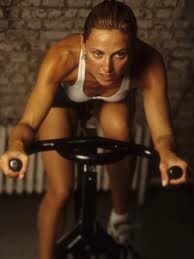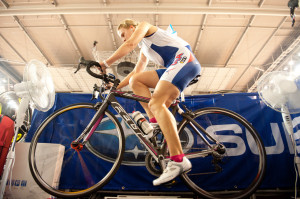Most people don’t even bother with a proper warm up before biking. They figure they’ll just ease into the ride and then kick it into high gear when everything starts to feel loose. It’s a common problem in all sports and recreational physical activity. As cyclists, we often take our bodies for granted and get ahead of ourselves before the rubber even meets the pavement.
This, is how injuries occur.
Knowing what to do before a bike ride can help settle nerves, set goals, reduce the risk of injury and improve overall cycling performance. A correct cycling warm up will address several things at once, so it’s important we integrate it into our race days, training sessions and even prior to an easy ride.
This article will briefly teach you the importance of warming up before cycling, and then show you a simple 5 minute routine that you can have in your arsenal at all times!
Source: Andriy Bezuglov – Adobe Stock
Why Warm Up Before Cycling?
One definition of intensity is the amount of load being put through the body during an exercise or activity. For example, doing a 1RM back squat is more intense than doing 50 bodyweight air squats. The heavy weight on your back is putting more axial load through the body than you doing a squat with no weight at all. With this definition, cycling is a low intensity exercise.
However, another definition of intensity is how hard the body has to work to do the exercise. Depending on your level of fitness, those 50 bodyweight air squats might take your RPE (rate of perceived exertion) to a level 8 or 9. With this definition, we can see how cycling could span the spectrum of intensity from low to high.
All this to say that cycling has the potential to place huge demands on your body despite its reputation for longevity and low impact on the joints. Yes, the bike supports your body. Yes, you push against free moving pedals instead of the immovable ground. Nevertheless, it is probably more intense than the rest of your day’s activities, so we need to prepare accordingly.
Source: brizmaker – Adobe Stock
Benefits Of A Cycling Warm Up
By performing a pre-ride cycling warm up you will increase the temperature and blood flow in your muscles. This has been shown to increase performance outcomes and reduce the risk of cramps or injury by making your tissues more pliable (“limbering up” so to speak).
Something else not often talked about is the psychological benefits to a warm up routine. This time can be used not only to prepare your body but your mind as well. Western medicine and society as a whole tends to compartmentalize the body and mind as different (sometimes opposing) entities. In reality, you as an individual are a complex intermingling of both.
Pay attention to how you feel prior to riding. Set goals for the session whether it’s for enjoyment, recovery, training or performance. Visualize the outcome of your race or desired sensations during your ride. Calm your nerves and avoid an “adrenaline dump” early in a race or heavy training session. All things we can attend to and include in the space of a dedicated warm up.
Source: fifeflyingfife – Adobe Stock
Should You Stretch Before Cycling?
It depends on the type of stretching. You’ll notice that all our warm up routines at Dynamic Cyclist are…dynamic. This means that we are constantly moving through a range of motion as opposed to just holding an end position (which is known as static or passive stretching).
A dynamic warm up is more productive in terms of increasing the temperature of your muscles and preparing them for movement. Static stretching also has a number of downfalls prior to exercise including the decreased neural excitation of your muscles. This means they won’t fire as quickly, won’t be as strong and won’t last as long.
Holding a static stretch means you’re asking the muscle to relax into a lengthened state. This is contradictory to what you want during exercise, which is for the muscle to contract forcefully for several repetitions. These opposing ideas are a recipe for injury. Best to save any static stretching for after your ride or a rest day.
Pre-Ride Warm Up
Now that you know a little bit about why a cycling warm up is beneficial, it’s time to actually do one! This is a full 5 minute warm up routine you can use before going out on any ride. We will show you the exercise, tell you how to do it and why it will contribute to better cycling performance.
Each exercise has an accompanied link that will take you to a follow along video teaching each exercise, led by our Dynamic Cyclist coach, Alisha. Let’s jump in!
March In Place
Try this exercise with Alisha!
Why It Works
- Warms up the hip flexors which play an important role in recovery phase of the pedal stroke; hip flexors tend to be dysfunctional in cyclists with lower back pain
- Balancing on one leg works unilateral stability and fires all your glute muscles which is important for power initiation while cycling and overall hip health
- Integrates hip and core musculature together; crucial for force absorption and production while riding
- Large movement gets the heart rate up, circulates blood and increases the body’s core temperature
- Cross lateral movement integrates your brains left and right hemispheres which results in better focus, peace of mind and improved motor functioning
Pulse Squats
Try this exercise with Alisha!
Why It Works
- Works all your knee extensors (quadriceps) which do the majority of the work while cycling
- The wide stance works your adductors (groin muscles) who, in addition to adducting the leg (bringing it towards the midline) also have a secondary hip flexing function
- Squatting deeply forces activation of the gluteus maximus, which is important for initiation of the power phase while biking
- Alisha’s cue to drive the knees out helps engage all other glute muscles including gluteus medius/minimus; important for single leg stability and support of the pelvis while riding
- Pressure from the saddle leads to several urogenital problems in cyclists (like numbness, infection and sexual dysfunction); this exercise opens up that sensitive area and stimulates blood flow to the surrounding tissues
Arm Circles
Try this exercise with Alisha!
Why It Works
- Important for shoulder health; cycling limits the range of our shoulders and never takes our arms into an overhead position
- Our shoulder joint is the most mobile joint in the human body, this exercise takes it through the full range of flexion and extension
- Mobilizes your scapula (shoulder blade) which becomes stuck and stagnant staying in prolonged, fixed positions on the bike
- Opens up connecting tissues in the chest and lats (under your armpit), both of which become compressed in a rounded, forward flexed cycling position
- Bringing the arms overhead helps mobilize the thoracic spine (mid back) which cycling and several modern activities tend to stiffen
Dynamic Forward Fold
Try this exercise with Alisha!
Why It Works
- Both strengthens AND stretches muscles on the front and back of your body through a large range of motion
- Stretches hamstrings and back on the way down, contracts them on the way up; Stretches core, chest and hip flexors leaning back, contracts them folding forward
- The core/chest stretch you get leaning back is great for maximizing your breathing capacity once you get on the bike where these tissues are crunched up and compressed
- You get a pumping sensation in the low back as you hinge forward and backward which stimulates blood flow to this often injured area
- Fluid movement that feels fantastic on the whole body; great for overall feelings of agility and nimbleness prior to riding
Dynamic Lizard
Try this exercise with Alisha!
Why It Works
- Integrates the whole body and helps it work together as a single unit prior to getting on the bike
- Great mobility exercise for hip health as you have to use your own strength to bring the hip into almost full flexion
- Prepares you for mounting and dismounting, where you perform a large hip movement very much outside the range of normal pedaling; often injures bikers at the beginning of a ride when they’re not warmed up or at the end of a ride when they’re fatigued
- Integrates loaded wrist extension into the warm up; it’s often overlooked that the wrists are under sustained load in different positions on the bike
- Loads the upper body, particularly the front of the shoulders, which are going to be working hard when leaning forward on your handlebars
Take Your Cycling To The Next Level
This was just one of the many warm up, mobility, injury prevention and strength workout routines we have available through our Dynamic Cyclist training platform. Also available is 1-on-1 coaching for a more personalized approach.
We want to help you ride pain free and feel your best on and off the bike! We hope you join us and become part of our community of cyclists committed to riding pain free!
 I used to show up to an event with just enough time to put my helmet and shoe’s on and get to the start line before the gun went off. (I Love my bed) Then I learned how important a proper cycling warm up actually was!
I used to show up to an event with just enough time to put my helmet and shoe’s on and get to the start line before the gun went off. (I Love my bed) Then I learned how important a proper cycling warm up actually was!